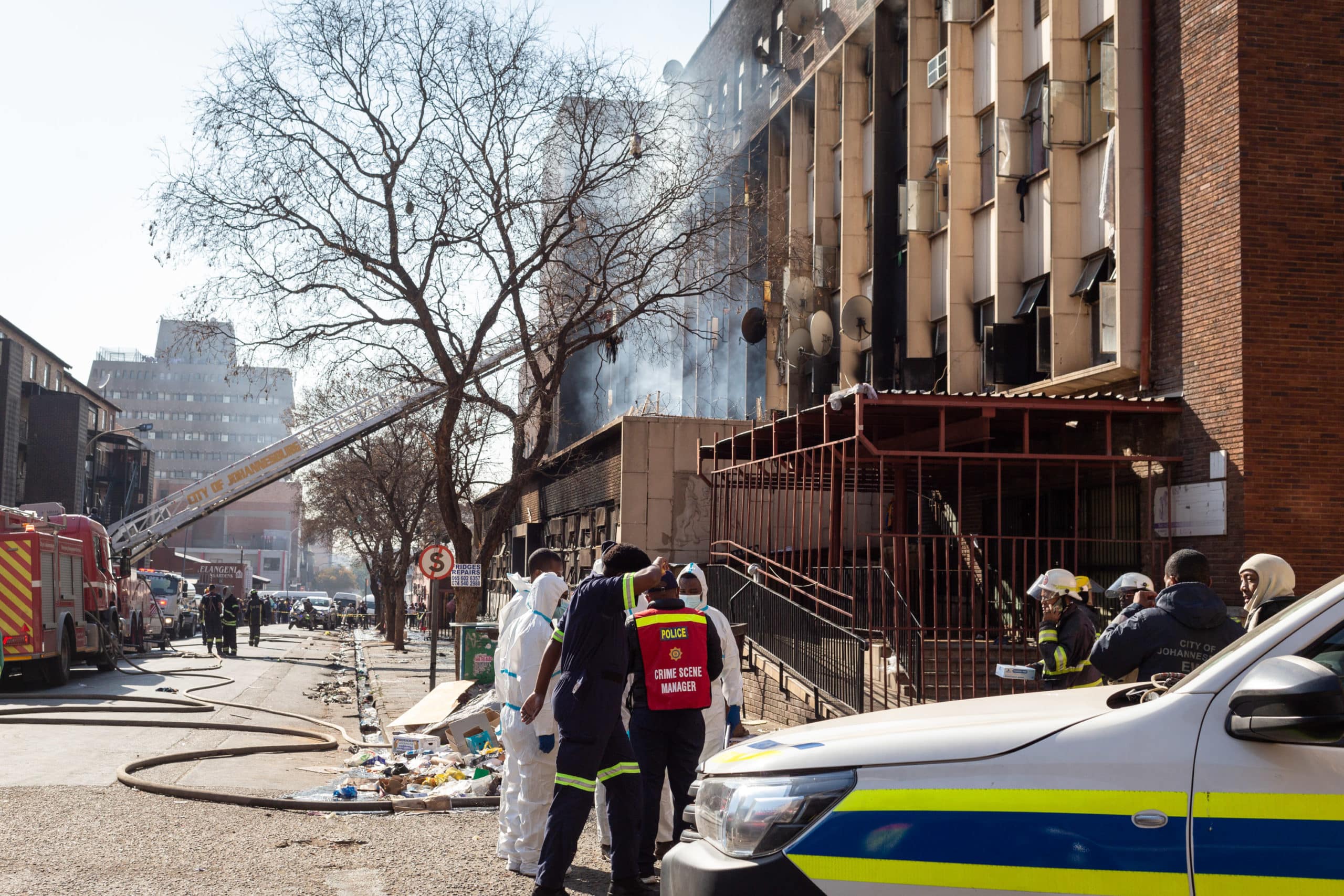Johannesburg’s heartbreak deepens as a heritage building fire claims 74 lives, exposing the urban decay in the CBD. Amid tales of despair and resilience, the tragedy raises urgent questions about illegal building occupations and housing challenges in the city.
Yet another tragedy has struck Johannesburg’s Central Business District (CBD), revealing the dire state of decay in the area. A fire that broke out in a designated heritage building has turned into a mass casualty event, leaving at least 74 people dead, numerous others injured, and countless individuals homeless.
The fire ignited during the early hours of the morning yesterday and swiftly consumed the lower floors, as reported by residents. In their desperate bid to escape, many people had to leap from the upper floors to avoid the flames. Police forensics personnel at the scene, speaking to FORBES AFRICA, confirmed that some victims had succumbed to impact trauma, while others perished due to burns or smoke inhalation.
One resident, who preferred to remain anonymous, described the harrowing experience: “It started around midnight, sounding like gunshots. We lived on the ground floor and felt the intense heat. When we fled the building, we saw flames raging above.”
Firefighters, police, and emergency services swiftly arrived at the scene as the day began, and a crowd of onlookers had gathered to witness yet another tragedy in the inner city, more deadly than the recent gas explosion on Lilian Ngoyi street, also in the CBD.
Loading...
Robert Mulaudzi, spokesperson for Johannesburg Emergency Services, stated, “The [victims] were treated for smoke inhalation and various injuries. The building was an informal settlement, heightening the risk of being trapped.”
As the death toll climbed, from 20 to 45, then 53, and now to 74, anguished cries could be heard from those who had lost loved ones. Dozens of people gathered on nearby streets, beyond the police cordon, carrying clothing, blankets, and essential supplies they had managed to salvage before the fire consumed the building.
A resident from the building across the road recounted, “Some people were jumping. Everyone was frantically trying to call 10111, the fire brigade, and the police, but it took them about an hour to arrive.”
The building, located at 80 Albert Street in Marshalltown, was originally the headquarters of Johannesburg’s Non-European Affairs Department when constructed in 1954. After the apartheid era, it served as Usindiso Ministries’ women’s shelter and clinic. Later, it became one of the many ‘hijacked’ buildings in the inner city, housing some of the most marginalized residents in cramped and unserviced quarters. Deeds office records indicate that the building remains in the possession of the City of Johannesburg.
FORBES AFRICA also visited two buildings across the street from the fire, housing both locals and foreign nationals, with no access to running water or electricity. Most rooms, the size of individual corporate offices, were crowded with three-four occupants, often including children. The situation of the 80 Albert Street building was no different.
The problem of ‘hijacking,’ or illegal occupation of buildings for residence, has long plagued Johannesburg’s CBD. In 2018, then Mayor Herman Mashaba’s spokesperson reported over 432 hijacked buildings in the city, a number that has likely grown since. Residents of 80 Albert Street, many of whom were foreign nationals, disclosed monthly payments between R1,000 ($53.5) and R2,000 ($107) for their occupancy.
Continual migration to Johannesburg in search of employment, coupled with a housing backlog exceeding 500,000 as of last year, forces many residents and migrants into alternative, often illegal, housing.
One resident interviewed by FORBES AFRICA expressed disbelief, learning that her friend Amanda, just 21 years old, had perished: “She was a child, and now she’s gone.”
While the nationalities of the residents remain largely unknown, many appeared to be of foreign origin, a point that quickly became a focal issue. Operation Dudula attempted to stage a demonstration near the site but was turned away by the police.
Mulaudzi stated: “The people living there, I don’t have all the details. Some might be South African citizens, and some might be foreign nationals, but this information is yet to be confirmed. It’s a mix of residents in that area.”
In conversations with local residents, some South African nationals alleged that poor safety conditions and the ensuing fire were a result of illegal activities. “They are selling drugs,” claimed the same resident who was a friend of the deceased Amanda. “It’s everywhere here.”
Several politicians were present, including Johannesburg Mayor Kabelo Gwamanda and the City’s MMC for public safety, Dr Mgcini Tshwaku. They spoke out against the incident, framing it as a nationalistic issue, and addressed the problem of building-hijackings within the CBD.
“As they remove the bodies, it’s evident that people were trapped. The bodies piled up because people on the first floor tried to escape, but the gate was locked. People were trapped. We need to deal with this issue – buildings are being hijacked,” Tshwaku emphasized. “At this time, the city doesn’t have alternative housing solutions.”
The death toll is anticipated to rise as emergency services continue their operations. This incident ranks among the deadliest building fires worldwide, highlighting the pressing issues faced in Johannesburg’s inner city.
Loading...
